
The Science of Self Confidence
Helping Leaders Gain & Demonstrate the Confidence they Need to Succeed
By Management Research Group
For leaders, demonstrating self-confidence is a necessity. Self-confident leaders are seen as more competent, and are often given more power and opportunities to lead. Leaders who demonstrate self-confidence continue to appear competent even after evidence to the contrary is presented.1 The robustness of perceptions of self-confidence highlights the importance of helping leaders develop the ability to demonstrate self-confidence as early as possible. This research summary will examine new global leadership research exploring the relationship between
self-confidence and effectiveness, the behavioral correlates of self-confidence and potential risks for individuals who are seen as highly confident. These findings will help practitioners and leaders determine the best path to developing and making the most out of their ability to convey self-confidence.
About the Participants


The Tool
LEA 360™: the Leadership Effectiveness Analysis
A multi-rater leadership assessment used in more than 100 countries, with more than 1 million total participants.

Observer Questionnaire
22 leadership behaviors
31 leadership competencies

Self Questionnaire
22 leadership behaviors
3 research items
Measuring Self-confidence
Conveyed Self-confidence
One of the competencies measured in the observer questionnaire.
On a 7-point scale, observers were asked to rate leaders’ self-confidence: Demonstrates self-confidence (i.e., appears to trusts his/her abilities, judgment and capabilities, conveys the capacity to achieve what he/she wants to achieve)
Felt Self-confidence
One of the research items in the self questionnaire.
On a 7-point scale, leaders were asked to rate their own self-confidence: I feel self-confident in my role (i.e., the degree to which I trust my abilities, judgment, capabilities, and feel that I have the capacity to achieve what I want to achieve)
Conveyed self-confidence and leadership impact
We explored the importance of conveyed self-confidence by studying its relationship with other measures of leadership effectiveness. Our findings align with previous research in this area, showing that conveyed self-confidence is related to many other measures of leadership effectiveness. Overall, leaders who convey self-confidence are seen as effective in moving forward in business, overcoming new obstacles, taking control and making effective choices.
Why Conveyed Self-Confidence is Critical
It correlates with leadership impact.

Relationship between conveyed and felt self-confidence
When helping leaders increase their ability to convey self-confidence, it is tempting to begin by helping them increase their felt self-confidence with the expectation that increases in felt self-confident will lead to increases in conveyed self-confidence. However, we found a weak relationship between the LEA measures of felt and conveyed self-confidence (r = .15). Moreover, felt self-confidence was not associated with any particular pattern of self-perceived behaviors.
Behaviors that impact conveyed self-confidence
To help leaders identify the most efficient path to higher levels of conveyed self-confidence, we conducted a relative weights analysis to determine which of the 22 LEA leadership behaviors have the greatest impact on conveyed self-confidence. Leaders who exhibit these high impact behaviors are also more likely to be seen as self-confident by their observers. The pattern of behaviors associated with conveyed self-confidence suggests that these leaders seek opportunities to be in charge and feel comfortable in that role, consider the long term impact of their decisions, exert influence and expand their expertise, are persuasive and do not prioritize others’ agendas.
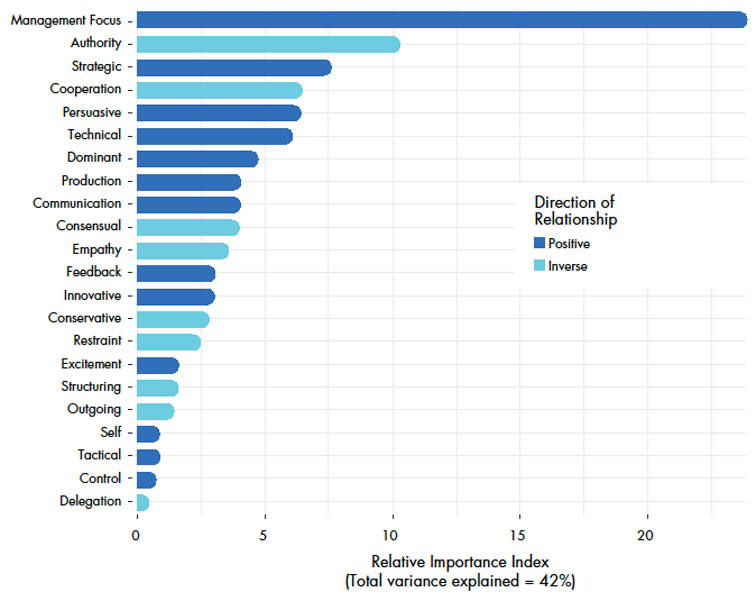
Conveyed self-confidence and demographics
To fully understand how leaders can increase their ability to convey self-confidence, it is important to consider any relevant contextual factors. We examined some of the nuances of conveyed self-confidence by exploring differences in self-confidence ratings by demographic group as well as differences in the behaviors that convey self-confidence in those groups.
Generations
We found no differences in ratings of conveyed or felt self-confidence by generation.

There were some differences in the behaviors that observers associate with conveyed self-confidence depending on the generation of the leader they were rating.
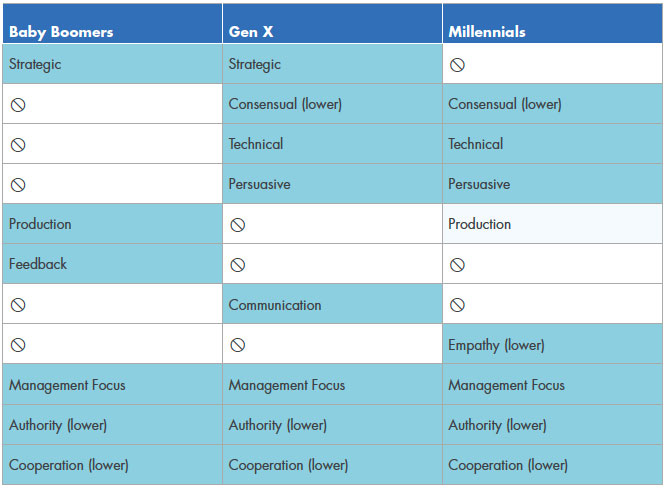
Gender
We found no differences in conveyed self-confidence by leader gender. However, men rated themselves higher than women on felt self-confidence.

There were some differences in the behaviors that observers associate with conveyed self-confidence depending on the gender of the leader they were rating.
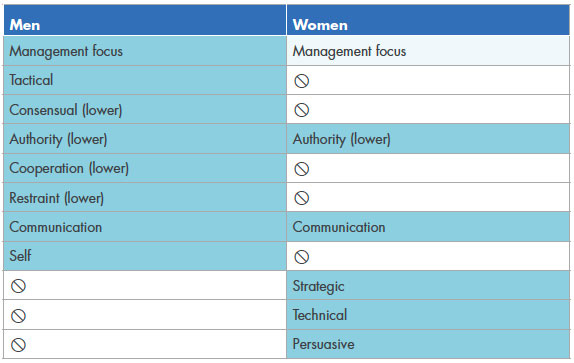
Avoiding the risks of high self-confidence
There are potential risks for leaders who convey high levels of self-confidence. To be their most effective, leaders who appear confident should also demonstrate competence in other skills. We explored the importance of also conveying a willingness to listen and ethical leadership. The analyses below only include leaders at the top 33% of conveyed self-confidence.

Conveyed Self-confidence and Willingness to Listen
Two groups of leaders who were high on conveyed self-confidence but differed in how well they conveyed willingness to listen were compared using Wilcoxon tests with p-values adjusted for multiple comparisons. The results show very different behavior profiles:
High Willingness to Listen + High
Conveyed Self-Confidence
People-focused cares about others, helps
colleagues, establishes rapport, asks for
help, thinks ahead, is cautious, expands
knowledge, communicates clearly and
remains calm and reserved
Low Willingness to Listen + High Conveyed
Self Confidence
Aggressive, independent, blunt, power-minded
Not only were there behavior differences between the groups, but conveying high self confidence + high willingness to listen makes a leader appear more effective across most of the LEA 360 competencies.

LEA 360 Leadership Behaviors: Comparing the two groups of leaders who were high on conveyed self-confidence but differed in level of conveyed willingness to listen
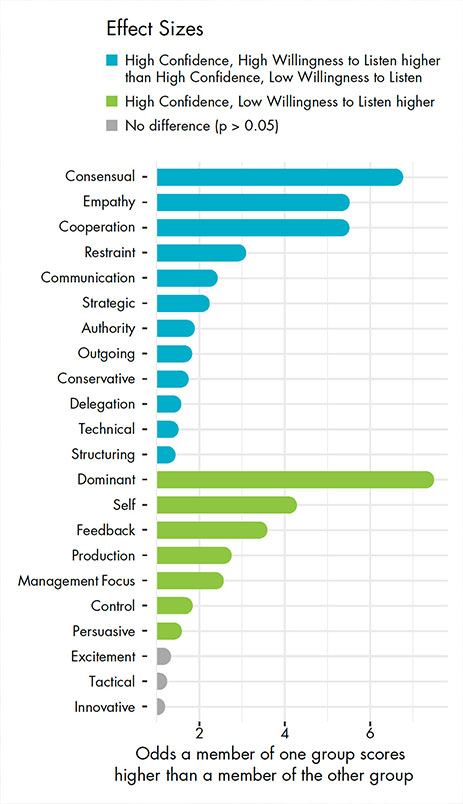
LEA 360 Leadership Behaviors: Comparing the two groups of leaders who were high on conveyed self-confidence but differed in level of conveyed willingness to listen
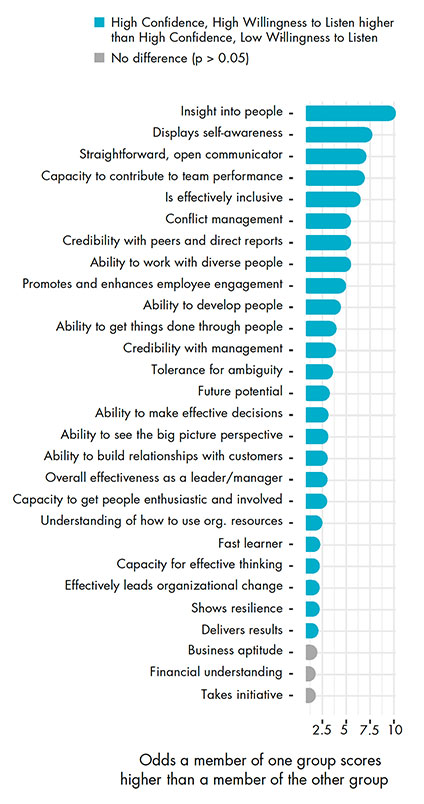
Conveyed Self-confidence and Ethical Leadership
Two groups of leaders who were high on conveyed self-confidence but differed in how well they conveyed ethical leadership were compared using Wilcoxon tests with p-values adjusted for multiple comparisons. The results show very different behavior profiles:
High Ethical Leadership + High Conveyed
Self-Confidence
Reserved, cares about others, helps
colleagues, communicates clearly, thinks
ahead, is cautious and organized, and
expands knowledge
Low Ethical Leadership + High Conveyed
Self Confidence
Aggressive, independent, may be blunt,
takes command, sells ideas and is
emotionally expressive
Not only were there behavior differences between the groups, but conveying high self confidence + high ethical leadership makes a leader appear more effective across all the LEA 360 competencies.

LEA 360 Leadership Behaviors: Comparing the two groups of leaders who were high on conveyed self-confidence but differed in level of conveyed ethical leadership

LEA 360 Leadership Competencies: Comparing the two groups of leaders who were high on conveyed self-confidence but differed in level of conveyed ethical leadership

About MRG
MRG is a global leader in designing assessments that foster a deep self-awareness and impact people in profound and meaningful ways. The MRG suite of scientifically designed instruments, backed by more than three decades of research,
includes solutions for Leadership and Personal Development, Sales and Service.
MRG assessments give you the tools to support unique leaders as they chart their personal paths to success and fulfillment.
Research from MRG
The MRG Research Library offers resources on team development, succession planning, diversity and inclusion, high potential development, leadership best practices, and much more.
Visit www.mrg.com/resourcehub/research to access this complimentary resource.
About the Authors
Maria Brown, PhD | Head of Research, MRG
Maria holds a Doctorate Degree in Psychology from Vanderbilt University. Before joining MRG, Maria was an Assistant Professor of Psychology at Murray State University, where she headed the Language Learning Laboratory. She regularly presents empirically-based insights on key topics in leadership to a variety of audiences around the world. Her research has been published in a number of scientific journals and her research on educational practices was recognized by the Society for the Teaching of Psychology.
Tricia Naddaff | President, MRG
Tricia has been consulting to individuals, teams and organizations for over 30 years and her experience includes coaching, product design, research, and business development. She has been a speaker for Tedx Dirigo, is a contributing author to the book Enlightened Power: How Women Are Transforming the Practice of Leadership, and is a contributor to Global Coaching Perspectives: the Association for Coaching Magazine (UK). Tricia received her graduate degree in Management from Lesley University and her undergraduate degree from Boston College.
Sources:
Kennedy, J. A., Anderson, C., & Moore, D. A. (2013). When overconfidence is revealed to others: Testing the status-enhancement theory of overconfidence. Organizational Behavior and Human Decision Processes, 122(2), 266-279.
Locke, C., & Anderson, C. (2015) The downside of looking like a leader: power, nonverbal confidence, and participative decision-making. Journal of Experimental Social Psychology, 58, 42-47.
Murphy, S. C., Barlow, F. K., & von Hippel, W. (2018). A longitudinal test of three theories of overconfidence. Social Psychological and Personality Science, 9(3), 353-363.
Connect with MRG
research@mrg.com | www.mrg.com | +1.207.775.2173 +353.1.280.4430

